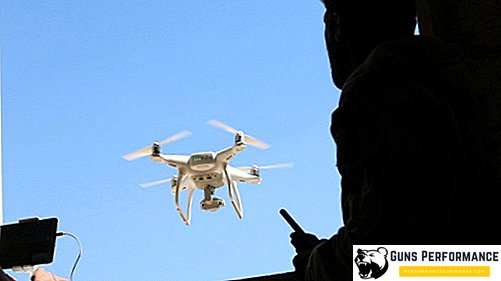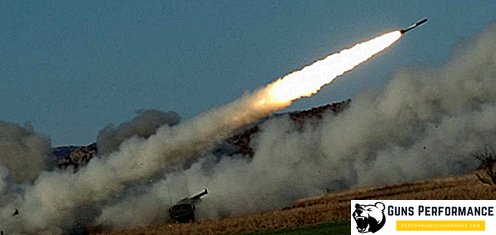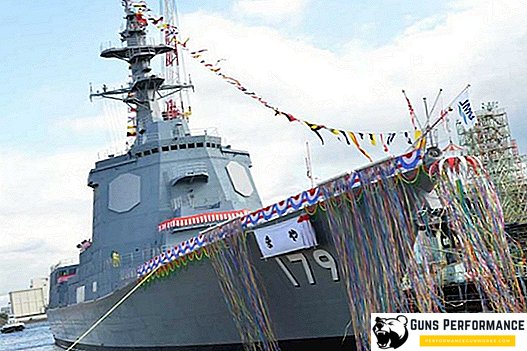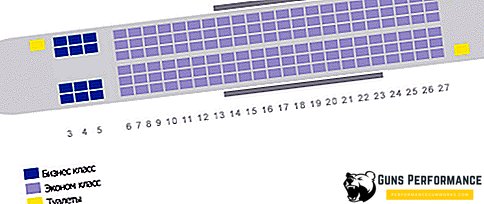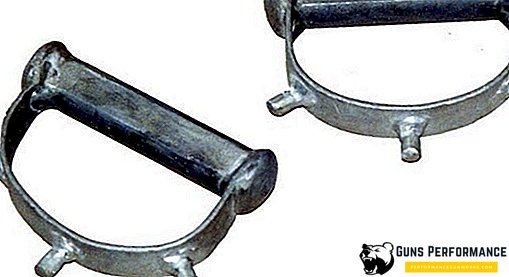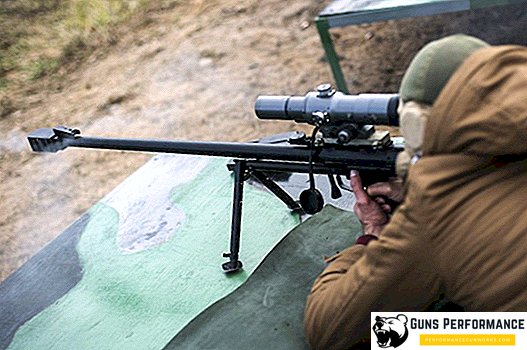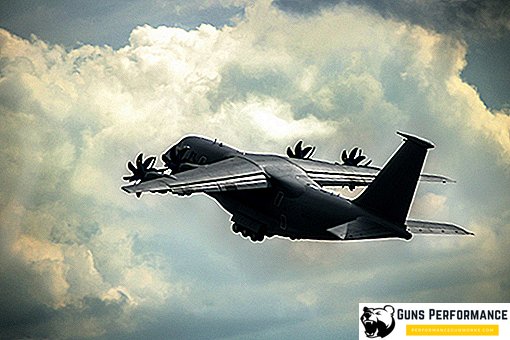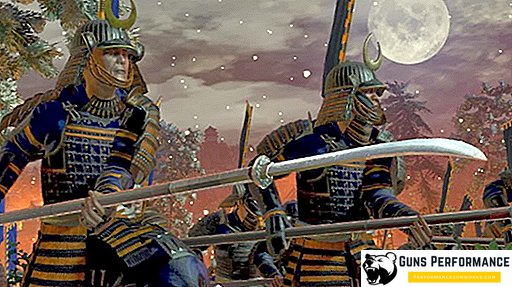
The Japanese and European classification of cold weapons are quite different. According to the latter, the famous Japanese katana sword is generally not a sword, but a saber with a curved blade and one-sided sharpening. The Japanese consider a sword any type of cold weapon with a blade length of more than 15 cm, a line of rigidity and a shank with a hole for a special thorn. A very wide range of bladed weapons falls in this category, from the short tanto dagger to such giants as naginata, with a length often exceeding two meters.
Naginatu is often called the Japanese halberd and is considered a pole weapon. Both are wrong. In their function and combat use, the naginata is more like a European glaive, although in design they are very different. In Japanese, the name of this weapon is written with the help of two hieroglyphs, the first of which denotes a pole, and the second - a curved sword. Literally, this word is translated as "long sword" or "sword on a pole."

Naginata is a cold weapon, which consists of a long handle (up to two meters) and a curved blade with one-sided sharpening. Its dimensions can reach 30 cm. Moreover, it should be noted that the wooden part of the weapon is not a shaft, as in the case of a glaf, namely an oval-shaped handle. This form greatly facilitated fencing, allowing you to beat off even the fastest sword or spear strikes.
The blade of the naginata is attached to the handle in the same way as similar elements in shorter swords. In shape, it also strongly resembles the blade of an ordinary Japanese short sword. From the handle, it is separated by a ring-shaped guard, sometimes supplemented by a metal crossbar, bent upwards or straight. These elements were used to parry enemy strikes.
At the lower end of the handle they usually fixed “ishizuki” - a special metal cap (often pointed), which served as a counterweight to the blade, and it could also be used for striking.
Known shortened versions of this weapon with a grip up to 1.5 meters. Usually they were used during training or such mini-naginaty made for women. You can also add that the size and appearance of naginat depended on the taste of the owner of the weapon and its individual characteristics: growth, physical strength, length of arms, etc.

Technique of possession of these weapons is called Naginadjutsu, and it is almost the ancient art of owning a traditional Japanese sword. The first mention of the combat use of Naginata can be found in the Kojiki Chronicle, it dates back to 712 Researchers studying the history of Japanese martial arts claim that there were more than 400 schools in the country that studied Naginadjutsu.
However, the most interesting is something else: despite its considerable size, the sword-naginata was and still remains the most "female" type of Japanese melee weapon.

Weapon history
As mentioned above, the first mention of the Naginats dates back to the beginning of the VIII century, it can be found in the famous Kojiki chronicle - a monumental monument of ancient Japanese literature. It mentioned sohs - legendary warrior priests - who used naginaty. It is likely that this weapon came to Japan from China (there exists a very similar analogue called Dadao), and then it was significantly improved in accordance with the Japanese military, craft and cultural traditions.

Naginatu can be seen in historical drawings depicting the battles of the Teng period (X century). The "Chronicle of Three Years in Oshu" (XI century) provides a detailed description of the use of these weapons in battle. From the narration it becomes clear how high the soldiers of that period evaluated the fighting qualities of the naginata. In the 12th century, during the so-called War, the Hepmei naginata became widespread as an effective means against enemy cavalry. The active use of this weapon even led to changes in the traditional Japanese armor: in order to protect the warriors' feet from naginata blows, special shin protection was introduced.
Judging by the ancient literary sources, the real virtuosos of possession of the naginata were the monks of Sokhei. We have reached the colorful descriptions of fights with the use of naginat during the fierce wars between the clans of the samurai Minamoto and Taira.

In the XIV-XV centuries. naginata became somewhat shorter and got the form we know today. At the same time tactics radically changed the tactics of hostilities, on the battlefield to replace the scattered groups of warriors came a close system of spearmen. Against long spears, naginata was ineffective. In the 17th century, with the advent of firearms, the combat significance of the naginata became even smaller.
However, the less naginata became useful for men, the more attention Japanese women paid to these weapons. When exactly samurai ladies "laid eyes on her" is hard to say. In medieval Japan, female warriors were not such an exceptional phenomenon, the annals are full of descriptions of their exploits. However, in the early periods they more often used a bow or a short sword for their combat achievements. It was believed that naginata is perfect for women in the beautiful half of humanity, because its length allows the enemy to be held at a considerable distance and thus eliminates the advantages of men in height, strength and weight. Naturally, not all medieval Japanese women could afford naginatajutsu, usually it was the privilege of aristocrats.

Noble women who lived in dangerous border areas in those turbulent times were not pampered or weak. If necessary, they fought side by side with their husbands or brothers. At that time, their position in society was very high, they often became managers of their possessions, which forced them to teach girls at least a minimum of military skills. It is likely that some Japanese ladies were not limited to this very minimum.
Naginata very quickly became a symbol of the status of women from the samurai class, often she was part of a dowry of girls from noble families. It was believed that with the help of these weapons, he was afraid of (“samurai woman”) is fully capable of protecting her home in the absence of her husband. A woman who owns the naginadjutsu technique could alone cope with a gang of thugs who had infiltrated her home.

The Tale of Military Troubles in the Biti Region describes how the samurai wife Mimura Kotoku, grabbing her favorite weapon and arming 83 more women, went into battle, "turning her naginata like a mill wheel". Then she challenged the leader of the attackers. The man refused to fight her, saying that she was a demon. Further in the chronicles it is said that women returned to the castle, making their way through the ranks of the enemy warriors.
Already in the middle of the 15th century, many traditional schools of Japanese martial arts introduced Naginadadzutsu into the compulsory education program. I must say that during the training the girls did not make any concessions, the requirements for them were also harsh and tough, as well as for the boys in teaching them kendo.
In one of the old Japanese treatises it is said that "learning the naginata, home economics and sewing will make a woman perfect." Here is Kinder, Küche, Kirche ("kitchen, children, church") in Japanese. It was believed that the occupation with the naginata brought up a strong will in women and made it possible to better understand the samurai traditions in order to become the ideal spouse of a warrior.

In the era of the warring provinces of Sengoku, a woman armed with a naginata could often be found on the battlefield. During this period, women often became the last defenders of tribal castles. There are numerous reports that the wives of some military commanders took whole "female squads" armed with naginats into battle. The case is described when 3 thousand women armed with naginats managed to defend the Toezakayama castle from an enemy detachment numbering 10 thousand soldiers. At the same time the attackers suffered significant losses.
A very common phenomenon was voluntary women's groups that defended a particular area from brigands or marauders.
However, already in the 18th century, the naginata practically does not occur on the battlefield; it moves to the dwelling, where it is stored as a family relic. This weapon was used in various ceremonies: at weddings, during the reception of honored guests, etc. Although, in the XVIII and even in the XIX century there are still cases of using naginat for their intended purpose. They were used in 1876 near the walls of the city of Satsuma, and also in 1868 in military clashes in Fukushima Prefecture. In both cases, these weapons were used by women.
The Meiji revolution put an end to the feudal remnants and in many ways broke the traditional foundations of Japanese society. The achievements of Western civilization began to be introduced at an accelerated pace in the country. In the end, these processes turned Japan from a backward agrarian country into one of the leading industrial states in the world. However, at the same time, the Meiji Revolution led to the decline of traditional martial arts, including naginadadzutsu. It took several decades to return the interest of the Japanese to the naginata.

In the mid-20s of the last century, Naginadjutsu was introduced into the program of Japanese educational institutions. Japanese officials decided that this ancient technique is best suited for strengthening the will, training the body and mind of girls and women of the Land of the Rising Sun. A so-called school naginata style was created, which was taught to Japanese girls.
Thanks to the efforts of enthusiasts (rather, enthusiasts), the art of Naginatajutsu was recreated and today is very popular in Japan. Nowadays, it has become a sport, which is called "Naginata". In 1955, the All-Japan Naginat Federation was created, which included all athletes practicing with this type of weapon. In 1956, the first championship was held. Naginata sports clubs are most often formed at various educational institutions.
You can also add that the naginata is one of the few (and maybe the only) combat sports in which the vast majority are women.
In recent decades, the naginata has begun a very successful expansion outside of Japan. This sport is already practiced in Europe, USA, South America and Russia. In 1990, the International Naginata Federation appeared. There were even three world championships: in Tokyo (1996), in Paris (1999) and California (in 2003).

Similarly with other types of Japanese martial arts, naginata has two types of competitions: the actual fights and demonstration of kata exercises. During the fight, the athlete gets points for strikes inflicted on different parts of the opponent's body. Sports blades of naginat are made of bamboo or oak, the participants of the fights are protected by a mask and armor.
Application technique
Naginata is a universal weapon that combines the strengths of a sword, a spear and a long pole. A samurai with a naginata could strike slashing and stabbing blows, while keeping the enemy at a considerable distance, as well as blocking the blows of his sword or other weapon. The metal tip on the lower end of the handle made it possible to carry out heavy deafening strokes, which were felt even for an opponent protected by armor.

Technique use naginaty very diverse, it includes a large number of different chopping and stabbing. These weapons can be applied accented blows, similar to those used in traditional kendo. Possession of naginata requires good physical fitness, and the hands and forearms should be especially strong. These weapons can perform a variety of circles and eights, throwing it from hand to hand. In the hands of a skilled swordsman, the lower end of the naginata bears no less danger to the enemy. They can perform various buttings, repel the blows of the enemy and in every way distract his attention, in order to then deliver the final blow with a blade.
A master naginatajutsu in battle can cover a space of 35 m2, acting like a deadly tornado.



